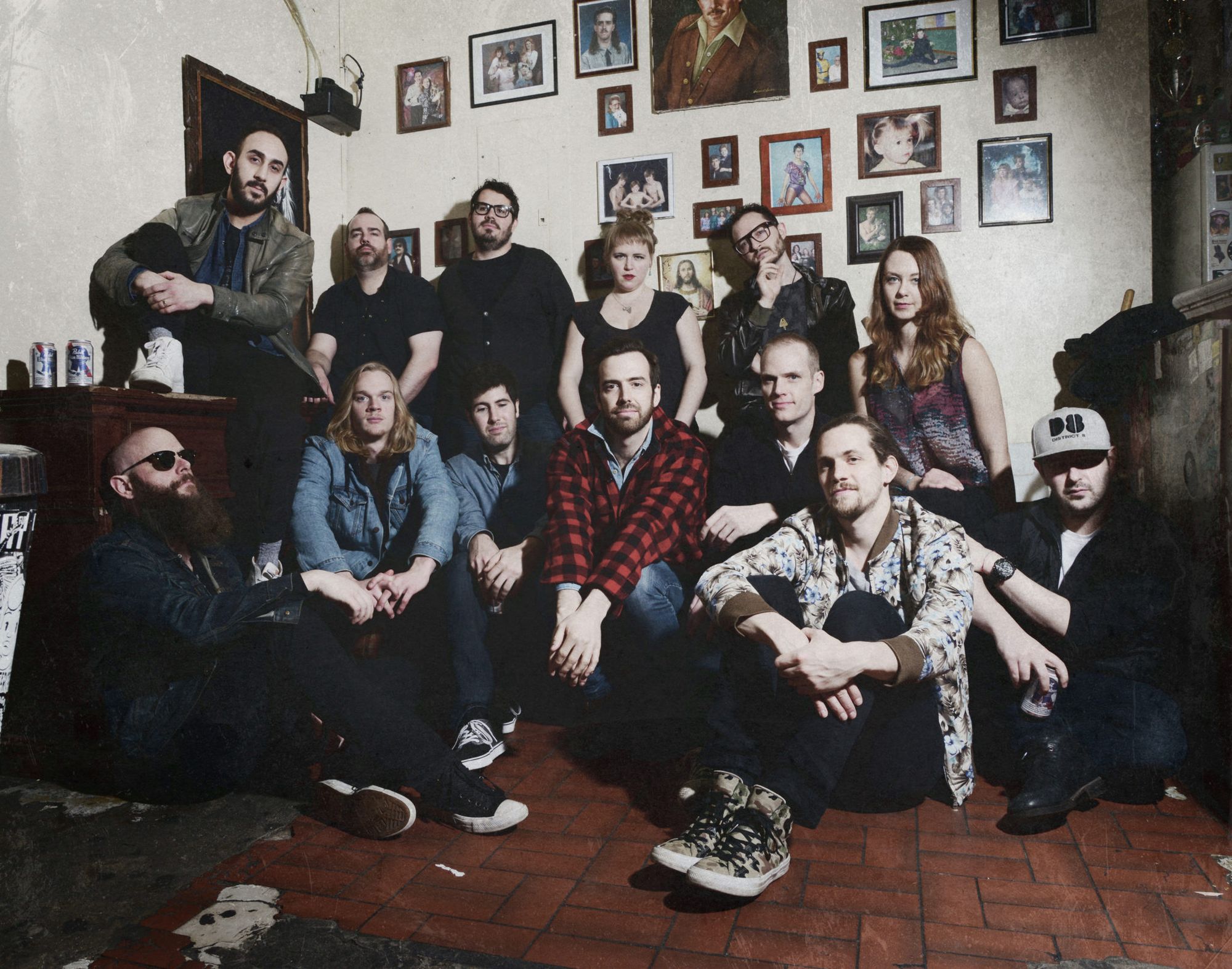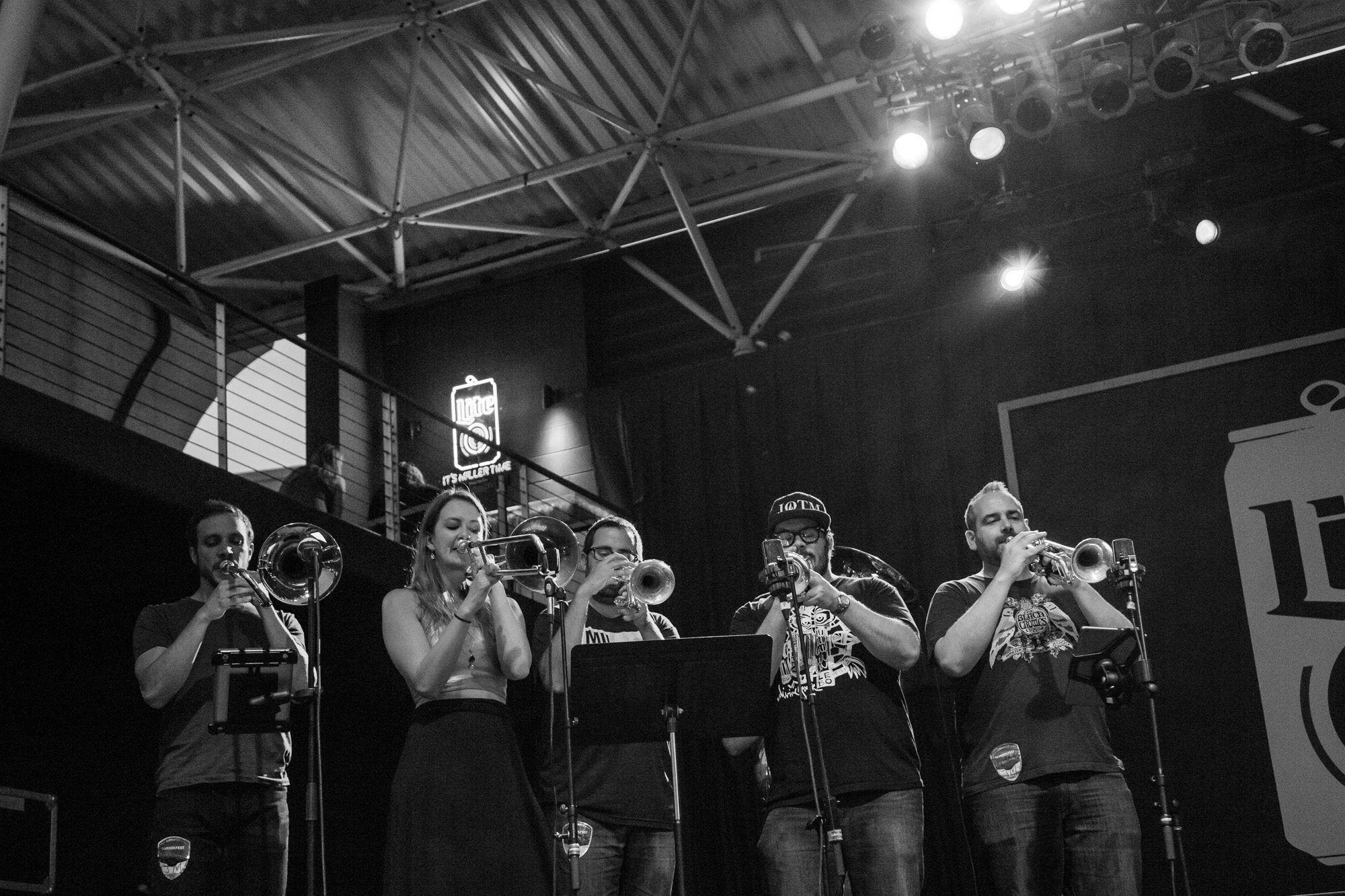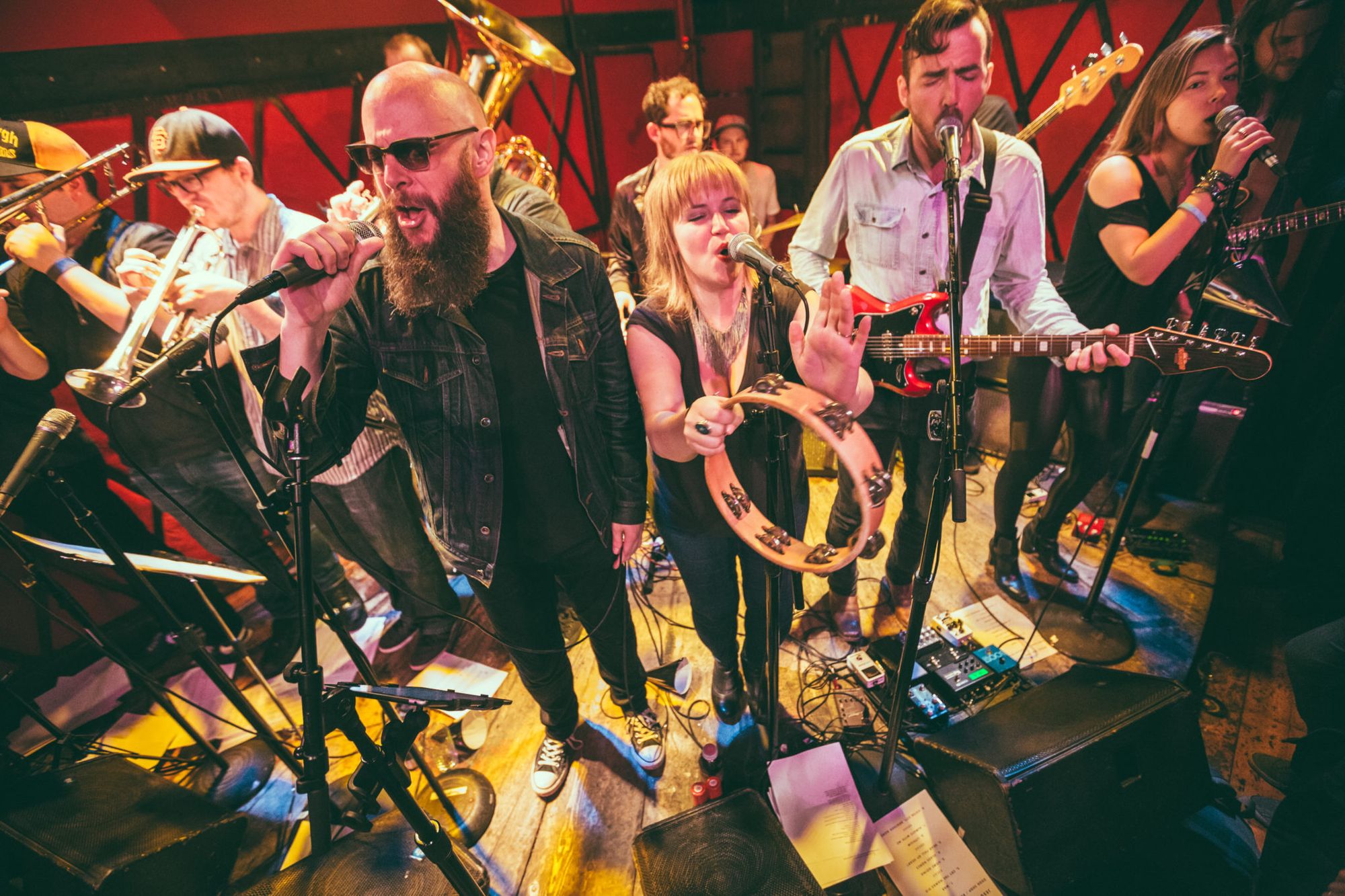Jesus On The Mainline: 15-Piece Band Delivers An Intimate And Lush Debut Album

Andrew Neesley and Tim Emmerick had individually forged some impressive musical credentials before they met. Neesley was an acclaimed jazz trumpeter and performed with artists as diverse as Ray Barreto, the Roots, James Taylor, and Lady Gaga. Emmerick, one of the first musicians ever to earn a Master’s degree in songwriting, was a fixture in New York’s indie rock scene. But it took a chance encounter, twice removed, on a Brooklyn street-corner to turn them into the songwriting partnership behind the 15-piece band Jesus On The Mainline and their remarkable album The Morning Bell.

Emmerick was back in New York after earning that Master’s and looking for a place to live in Brooklyn. He was waiting for a realtor in front of a potential apartment in Bed-Stuy when he spotted one of the building’s residents out walking his dog. “He was wearing a t-shirt that had Zildjian [cymbals] on it, so I knew he was a musician, I knew I was going to be able to trust him. I was like ‘I’m a musician. Is the apartment cool?’ And he was like ‘Yeah, man,’ and so I ended up moving in.”
There was a third musician living in the building, Mel Flannery, who was a friend of Neesley. She connected the dots, and soon Neesley and Emmerick were playing together in a variety of settings. Fast forward a few years, and Neesley recruited both Emmerick and Flannery (and a dozen other musicians) into a band that eventually took the name Jesus On The Mainline.
The band first established itself as a live act, with recording coming later. Neesley had made a name for himself arranging and performing Afro-Cuban jazz for the Bobby Sanabria Big Band, so creating parts for a 15-piece group was well within his wheelhouse. Given the talent and creativity of the musicians he’d recruited for Jesus On The Mainline, “Andy would give them charts that would have sections that just said ‘Open’ that were open for solos,” Emmerick recalled.
There were plenty of “fireworks” in the group’s live performances, Neesley said. “We had people that could light your hair on fire with a solo.”

When he brought Emmerick into the band, Neesley was doing most of the group’s composing as well as arranging, but his new sideman discovered right away that the trumpeter was open to sharing the spotlight with other musicians.
“Right from the first gig,” Emmerick remembers, Neesley told him, “Write something for the band. If you have ideas, bring them in.”
“And they were really good tunes,” Neesley said. “They were some of my favorites.”
“I was like, alright, I’m gonna take this like a project, just as a writing challenge,” Emmerick said. “I wanted to write something I thought would be good for the band. I had to find the groove of it, but I think it was a year, or year-and-a-half of being in the band we started writing together. Then it started happening pretty fast. It grew as we figured out how to work together.”
In most art forms—literature, theater, film—the greatest works are products of a single author. Songwriting is an exception; many of the most celebrated songs are works of songwriting teams, and there are a couple of different models for successful partnerships.
“There are a lot of classic relationships that are specifically a lyricist and a melodist,” Neesley said. “We’re definitely much blurrier than that. Our process is a lot more collaborative.”
Emmerick compared their method to a team like John Lennon and Paul McCartney, who regularly worked as collaborators but produced songs that were typically the primary work of one or the other. ”We’ll definitely do that. We both will bring songs in that are pretty much like whole cloth. And then we’ll usually make a little tweak here or there.”

That kind of song, though, is an exception to the rule for Neesley and Emmerick. “The majority of things, it’s usually we’ll start from an idea, like a melodic idea or a title. I’m really into starting a song with a title and going from there, and it’s kind assembled by a two-person committee,” Emmerick explained.
“There are times when one of us will bring a song in and it will be fully realized,” Neesley said. “We’ll still nip at the edges of it just to see if there’s anything else there. And then we’ll be like, ‘We’re just changing this to change things,’ and we’ll go back to the way it was—it was already done.”
One of the most important features of songwriting as a team, Emmerick, said, is “a little camaraderie, a little affirmation and a little motivation. There are so many times we set a date to write where we sat in my kitchen and I would be like ‘I don’t feel like doing this,’ and Andy would be like ‘I don’t feel like doing this,’ and we would be like, ‘Well, we’re doing this.’ And then, after the fact, having a beer to celebrate the fact that we did it.”
As their body of collaborative work grew, Neesley and Emmerick determined to record an album that would document their songwriting. They realized immediately that for practical reasons, they would have to adopt a different approach than the one Jesus On The Mainline had pursued in live performance and an earlier EP.
“We knew we were going to do a full-length record, and we were going to have limitations in terms of budget and time,” Emmerick said. “If we were standing there with the brass section going, ‘I don’t know. Let’s have another take with you guys just doing a second line and let’s see what happens,’ we would burn an hour or two in the studio.”

Instead, he said, “we had charts written out for everybody. Pretty specific, which I think the cats in the band actually appreciated. The arrangements have a lot going on, on a person to person basis. I think they like it in that sense: ‘oh, there’s the chart. I play that.’ It was more like that than ‘OK, let’s try something and see what happens.’”
Those arrangements are crucial to the extraordinary sound the band achieved on The Morning Bell. The music is lush and dense, but it also has an intimacy one wouldn’t expect from such a large ensemble.
“We try to figure out how to use all the parts a little differently.” Neesley said. “Where the brass used to play very powerful, pounding stuff, we did a lot of quieter stuff, blending tones and not just using the brass as one piece all together—How does that trumpet work with that guitar, or the organ with the two trombones? How does the tuba work all on its own? Instead of a rhythm section and a brass section, it’s thinking about all the people together playing their individual instruments.”
Another element that marks the album is the frequent use of choral vocals that Emmerick describes as one of the “signature decisions” of the recording.
“Most of the time it’s Andrew and me singing together, either just doing unisons or we’ll do octaves sometimes, usually both of our voices doubled, either an octave or a unison. And then kind of panned and delayed a little bit.”
“There are times when it’s four of us. Andy and I and then Mel Flannery and Natalie Cressman, all four of us together. Us two doubled in the range where we like to do the vocals but then Mel and Natalie in the same spot and then I’ll do a falsetto with them that will be kind of set back in there.”

Emmerick’s description is either straightforward and simple or impenetrably complex, depending on your understanding of music theory, but the result is an absolutely striking success whether you can grasp how they got it or not. It’s one of the disparate elements that makes the album immediately appealing and also lends a depth that rewards—and compels—repeated listening. They are all evidence of how deeply the partners thought about this project.
“It’s so strange, because if you take any one of those parts away from some of those songs, they become completely different songs,” Neesley said.
Through composition, conception and execution, Neesley and Emmerick as a team put an indelible stamp on The Morning Bell, but the album also relies on the contributions of the other musicians as well as the work of engineer Aaron Bastinelli.
“The thing that happened,” Emmerick said, “and it happened almost every single day: we recorded having a deep knowledge of what exactly all the parts were. But you get in a room and the ideas start coming. There was stuff that was fundamentally in the idea of the song that wasn’t even in the demo. Somebody in the band’s hearing it, and playing it. And we were like, ‘Yeah!’ That happened every day.”
Bastinelli’s presence is manifest in several of the “signature sounds” that make The Morning Bell such a cohesive experience, including the rolling drums that swell and subside in “Glass Bones” or rise out of the sparse opening of “Synesthesia” and storm through to the conclusion.
“Specifically, the foundation was Aaron working with our drummer Anders [Fleming],” Emmerick said. “I think their aesthetics and their tastes line up.The actual drum kit that Anders has, he got a handful of awesome, old, vintage 60s kits that are in great shape, and he takes care of them properly. Great drummer, good instrument, and the engineer and the player are sympatico.”
Bastinelli was also fundamental in shaping the guitar tones on The Morning Bell. Emmerick played guitar on the album himself, along with Andrew Miramonti and Simon Kafka.

“Thinking of my go-to choices and how I would get like a clean tone or a crunchier tone,” Emmerick said, “Aaron would be there putting a mic right on the amp or whatever. A couple of different times we’d be in there trying to get some takes and he’d be like, ‘It’s not happening. The tone, it’s just not happening.’”
“I’d be sitting there, like I thought it was good. I thought it was fine. But he was not bashful of like, ‘It’s just not cool.’ He definitely had an idea in his mind’s ear of something that was going to be cool, and it was a little different than what we were thinking of. He hipped us to some 70s fuzzy guitar sounds that I think neither of us would have gone to.”
Those 70s guitar riffs came from a different era. Emmerick and Neesely are painfully aware of launching this record when the time-tested formula for marketing popular music has collapsed and no one’s quite figured out what’s going to replace it.
“If you think about this little teeny window where people were flying on jets with their band logo on the side of it, that was like a blip of a moment,” Emmerick said. “Guys could be like genuine full-time rock stars. Would it be awesome to be like, not on the Zeppelin jet, but even to be like a member of Foghat? Yeah, it would have been cool.”
But the uncertain commercial atmosphere for pop music also birthed a certain freedom to commit fully to the creative process, Neesley said. “One of our aims was definitely to not care about how people were going to discover the music or how they were going to respond to it. We wanted to make a record that we were going to love and live with for the rest of our lives. Reception be damned, this is what we were going to do.”
“We’re in this. We’re not going anywhere. So if we’re going to be in this, let’s do it right. Let the chips fall where they may.”




